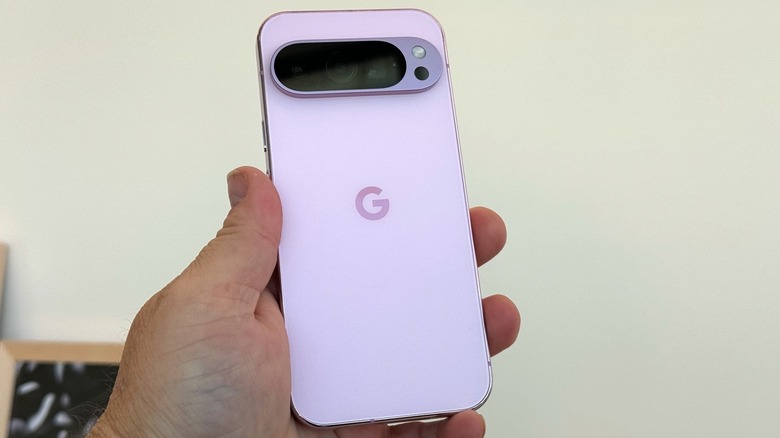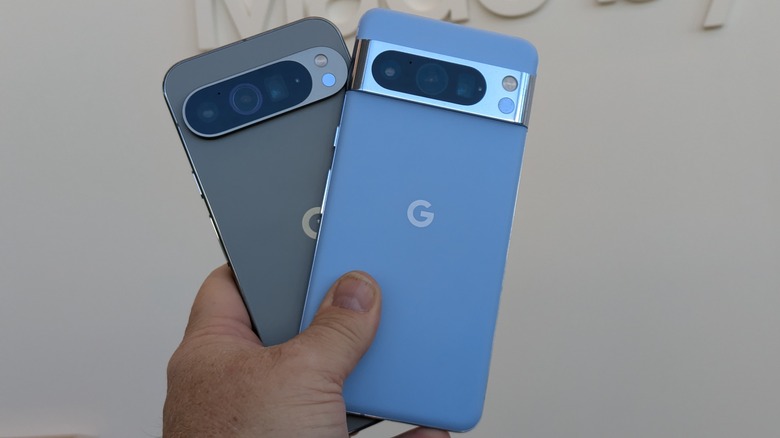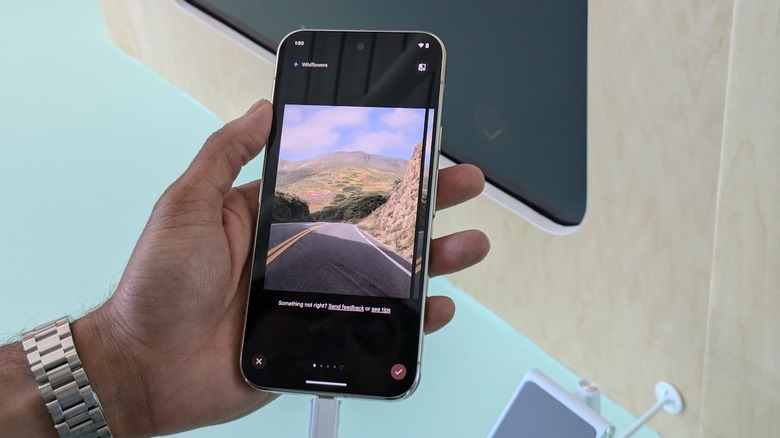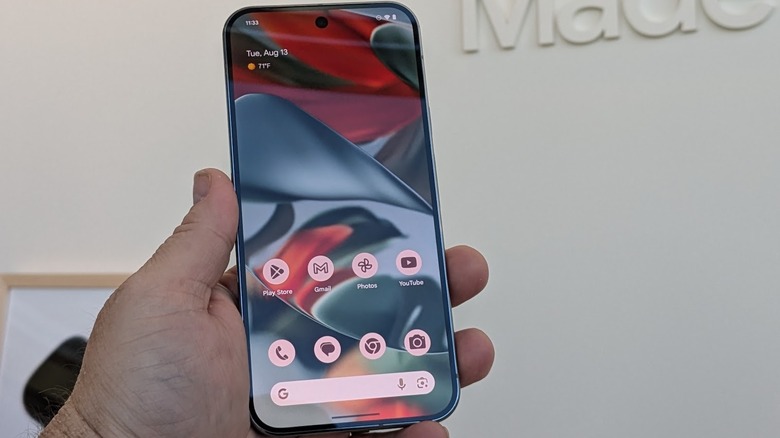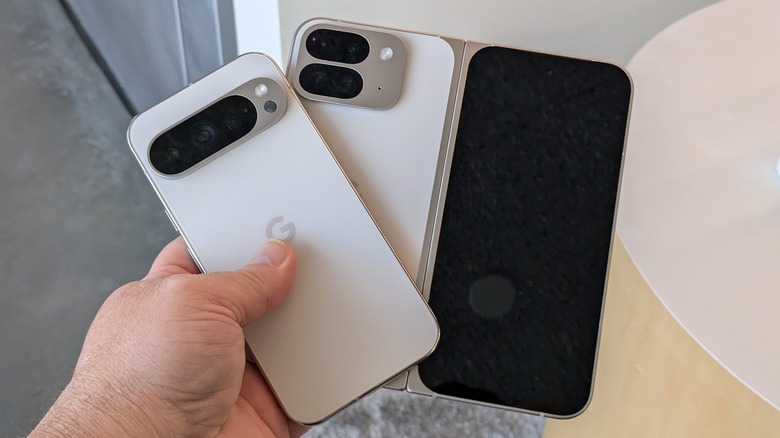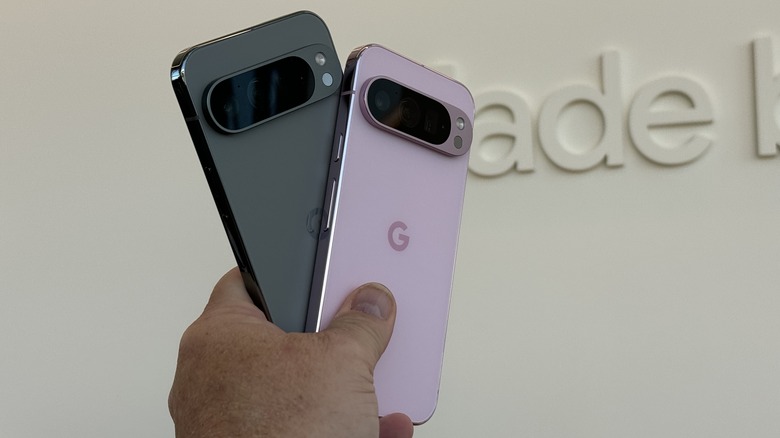Here's What's Actually Different About The Pixel 9 Pro
Made By Google is Google's annual hardware launch event, and the company has a slew of new devices to show off. In addition to updated versions of the Pixel Watch and Pixel Buds, Google also updated its phones. This year, the Google Pixel 9 Pro is getting a larger sibling — the Pixel 9 Pro XL. Unlike the Pixel 9, which comes in just a single size, you'll be able to choose from the Pixel 9 Pro with a 6.3-inch screen or the Pixel 9 Pro XL, which will carry a 6.8-inch screen. Other than that (and the battery size), everything will be identical between the two phones.
Google is also doubling down on AI because it's 2024, and that's what a company needs to do to show that it is ... ahem ... innovating. I attended Google's event in Mountain View, California, and got to spend some time with the new phones. Here's what Google is bringing to the 2024 Pixel 9 Pro.
New hardware specifications
In addition to the aforementioned screen size differences, the Pixel 9 Pro and Pro XL have different battery capacities, with the Pro clocking in at 4,700 mAh and the Pro XL at 5,060 mAh. Aside from the screen and battery, both models have the exact same specifications. Like the Pixel 9, both phones support 45W charging and wireless charging, though Google didn't give out wattage on the latter, saying only that it is Qi-certified. According to the company, when charging with a cable, you can get the battery up to a 55% charge level in 30 minutes.
These phones also get Google's Tensor G4 processor, which is a mild upgrade from the Tensor G3. Google likewise upped the RAM to 16 GB in the base models with storage options ranging from 128 GB up to 1 TB. Also gone is the Geordi La Forge camera visor on the back of the phone — the camera island is still horizontal across the back side, but the camera bump ends before it reaches the edge of the handset. I'm a little disappointed that's the case, as I really liked the visor and the fact that it had its own of ramp. The new design doesn't look bad, but I'll miss the old camera bump for sure.
Doubling down on AI
Google is pushing AI pretty hard by offering one year of Google One AI Premium with the purchase of the Pixel 9 Pro. This premium package lets you get access to the more powerful version of Google's AI assistant, which you'll also be able to access in Google Docs and Gmail. Most notably, you can use it to ask Gemini to summarize documents for you in Google Docs and to keep you up to date on your email. Google One AI Premium also includes 2 TB of cloud storage.
Beyond that, the company has added a new app called Google Screenshots — yes, it's an app entirely for screenshots. What Google wants you to do is to take a screenshot of things you need to remember, like your car's license plate or the invitation to a party. Then, later on, you can conversationally ask Google, "When is that party?" and the Screenshots app will locate the info you need via the image.
Why Google felt it had to make a whole separate app just for screenshots is unclear. It feels like a better implementation of this concept should have just been built into Google Photos, which is where all your images can already go. Plus, when I need to remember things, it's usually something like my parking space number, which I'll usually take a photo of — not a screenshot. This isn't necessarily a bad thing, but Google is a company known for killing off products, and Screenshots feels like it's already on the chopping block.
The camera is getting more AI, too
Google is also adding more AI features to its camera, but didn't really upgrade anything about the hardware. There is a new 42-megapixel camera, which is nice, and a new macro focus ability with the 48-megapixel ultrawide camera. Other than that, the camera specifications for the Pixel 9 Pro are the same as the Pixel 8 Pro, which was already quite a good camera. So, Google is mixing in some AI and calling it a win.
One feature is called Add Me — with it, you can take a photo of a group of people, and then have one person break off from the group and come collect your phone so you can join the group and take another photo. Google can then splice those two photos together into a single photo with all parties in the shot. It's a very cool and way-overdue feature that should allow more people to be a part of their own photos.
Satellite connectivity
One other neat feature that isn't particularly new — but is new to the Pixel line — is the Satellite SOS feature. This is very similar to what Apple was doing with its initial launch of satellite connectivity almost two years ago. Companies like Qualcomm have also brought satellite communications to their processors, but that attempt fizzled before it got off the ground. Meanwhile, Apple has evolved satellite connectivity so you can send non-emergency messages now, too.
Back on the Pixel 9 series of phones, you can connect to a satellite to contact emergency services, which is basically where Apple kicked its own feature off. Now it's coming to Pixel, which is pretty great. No longer should cellular coverage be responsible for life-or-death situations. It remains to be seen if Google will similarly expand this capability in future generations, but for now it's enough to know that the company is looking into the technology.
New price, old price
Unlike the Pixel 9, the Pixel 9 Pro is staying at its same $999 price point, with the Pixel 9 Pro XL joining the family at $1,099, making both models a pretty good deal. You're still getting an amazing camera set (even if it is similar to the Pixel 8 Pro), but you're adding on satellite capability and some neat AI features. All that rounds out to be a pretty premium device in the Android space.
Meanwhile, the larger size of the Pixel 9 Pro XL will appeal to those who want the extra screen real estate. That's a win. Keeping the Pro at the same price is the icing on the cake. I'm personally still not convinced that AI is the way of the future that Silicon Valley has decided it is, but if that turns out to be the case, the Pixel 9 Pro seems like a smart implementation of it.
